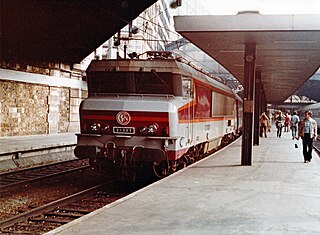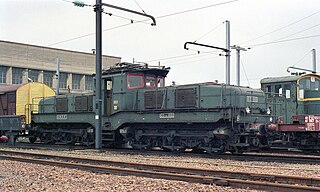
The SNCF BB 16500 were a class of electric locomotives built by Alsthom between 1958 and 1964 for the SNCF.

The SNCF BB 26000 locomotives are a class of dual voltage, four axle B'B' electric locomotives capable of a top speed of 200 km/h built by GEC Alsthom between 1988 and 1998 for SNCF. The locomotives are also commonly known as the Sybics.

The SNCF Class BB 27300 is an electric locomotive. There are 67 BB 27300 locomotives, built as part of the Prima range by Alstom. The first BB 27300 were delivered starting in 2006. Painted in the blue and white livery of Transilien, the brand name for the SNCF network around Paris, these locomotives are the passenger equivalent of the freight-only SNCF Class BB 27000 and are equipped for push-pull operation on suburban passenger services in the Île-de-France region around Paris, working with refurbished VB2N double-deck carriages.

The SNCF Class BB 27000 "Prima" electric locomotives were built by Alstom between 2001–2005. These are dual-voltage freight-only locomotives; they are not fitted with a 1500 V DC electrical line for train heating and accessories. One hundred and eighty of the locomotives, numbered 27001–27180, were built for Fret SNCF, for use on freight traffic. Their introduction led to the withdrawal of several elderly electric types, including Classes CC 7000, CC 7100, BB 8100 and BB 12000. They have also made significant inroads into Classes CC 6500, BB 8500, BB 16500 and BB 25500.
The SNCF BB 20011 and SNCF BB 20012 were electric locomotives used for testing, built by Alsthom between 1985 and 1986. The two locomotives were the synchronous dual-voltage prototypes for Class BB 26000.

The SNCF Class BB 7200 is a 1.5 kV DC electric locomotive operated by the SNCF in France. It is the DC version of the 'Nez Cassé' family of locomotives built between 1976 and 1985 by Alstom. They are rated for 4,040 kW (5,420 hp) of continuous power. SNCF Class BB 15000 is the AC version while the Class BB 22200 is a dual-voltage version. Another relative is the NS Class 1600 operated in the Netherlands, a DC locomotive based on the BB 7200. Intended primarily for passenger service, increasing numbers are being allocated for freight service with lower-geared bogies as passenger services are taken from locomotive-hauled coaches by TGV services. BB 7200 operations are limited to the French 1.5 kV DC electrified network in southeastern France, from Paris southwards. In 2016 48 were allocated to freight, 58 to intercity passenger service, 50 to regional passenger service, and two to auto-train service.
The SNCF class BB 20005 locomotive was a prototype locomotive of the BB25150/BB25200 series, transformed from the damaged BB16028 in 1961. After the end of its test period in 1975 it was reinstated with its original equipment under its original number BB16028.
The SNCF Class BB 30000 electric locomotives were built by Fives-Lille, CEM and MTE in 1961. They were the tri-current version of BB 9400 "Vespa" locomotives, of which they were closely derived, and inherited much of the knowledge of the experiences of BB 20004.

The SNCF Class BB 36000 locomotives are a class of triple voltage 4 axle twin bogie electric locomotives built by GEC-Alsthom between 1996 and 2001 for SNCF.

The SNCF Class BB 8500 class are part of a series of electric locomotives built by Alsthom for SNCF. They are the direct current version of the 25 kV alternating current SNCF BB 17000 and dual system SNCF BB 25500.

SNCF's BB 25500 class are part of a series of electric locomotives built by Alsthom. They are the dual system version of the BB 17000 (AC) and BB 8500 (DC) locomotives (17000+8500=25500). They are fitted with monomotor bogies with two different gear ratios. This allows them to have either increased tractive effort for freight, or a higher top speed. This makes them suitable for both freight and passenger trains.
The Class BB 8700 electric locomotives were rebuilt from the BB 8500 as the first subseries for the growth in Maurienne.
A monomotor bogie is a form of traction bogie used for an electric locomotive or diesel-electric locomotive. It is distinguished by having a single traction motor on each bogie.

The SNCF CC 40100 was a French class of quad-voltage 4,340 kW (5,820 hp) electric locomotives. They were intended for high-performance passenger services on the Trans Europ Express (TEE) routes of the 1960s and 1970s. This non-stop international working required them to support the electrical standards of several networks. They are significant for combining three innovations in locomotive design: quad-voltage working, three-axle monomotor bogies and the new 'Nez Cassé' body style of French locomotives.

The BB 13000 class were electric locomotives operated by SNCF in France. They were one of four classes, together with the BB 12000, CC 14000 and CC 14100 classes, that formed an experimental group for studying the practicality of the new French 25 kV 50 Hz AC electrification.

The BB 25150 is a class of electric locomotives in service with the French railways SNCF, built by Materiel de Traction Electrique (MTE) between 1967 and 1976. They are dual voltage locomotives working off both 1500 V DC and 25 kV 50 Hz AC. Designed by André Jacquemin, the class is a development of the earlier BB 25100.

The CC 21000 was a class of electric locomotives in service with the French railways SNCF, built by Alsthom in 1969 and 1974. It was a dual voltage version of the CC 6500 class working off both 1500 V DC and 25 kV 50 Hz AC. Initially allocated to Dijon, the first two, CC 21001 and CC21002, were fitted with cab signalling to allow them to operate test trains on the new high speed lines.

The SNCF Class CC 1100 was a class of 12 centre cab electric shunting locomotives, the first two of which were originally ordered for the PO-Midi. Originally numbered E 1001–E 1012, under the 1950 SNCF renumbering they became CC 1101–CC 1112. They were built by Batignolles-Châtillon and Oerlikon, the first two, E 1001 and E 1002, in 1937 and the remaining ten, E 1003–E 1012, between 1943 and 1948. Completely rebuilt between 1989 and 1995, the last was withdrawn from service in 2005.

The BB 20100 was a small class of two groups of two dual voltage electric locomotives of SNCF intended for cross-border traffic between France, Switzerland and Germany.














